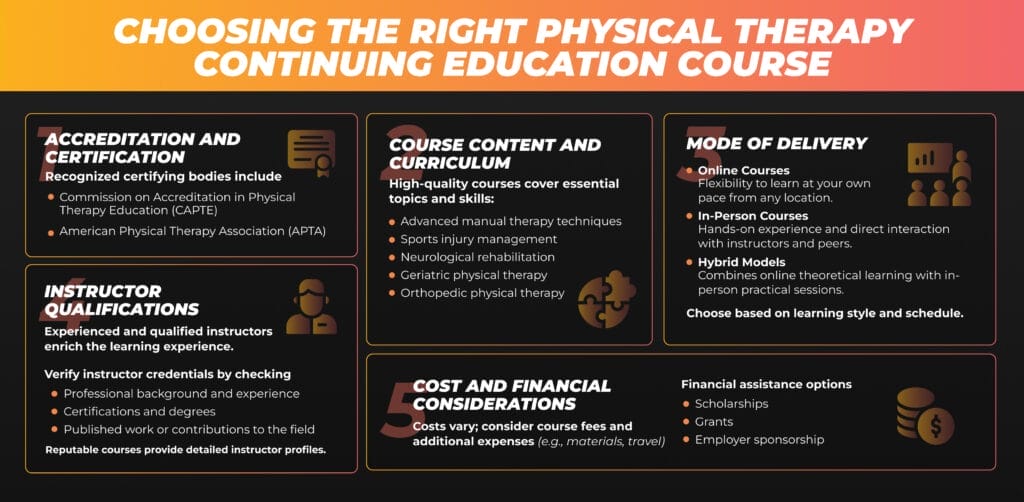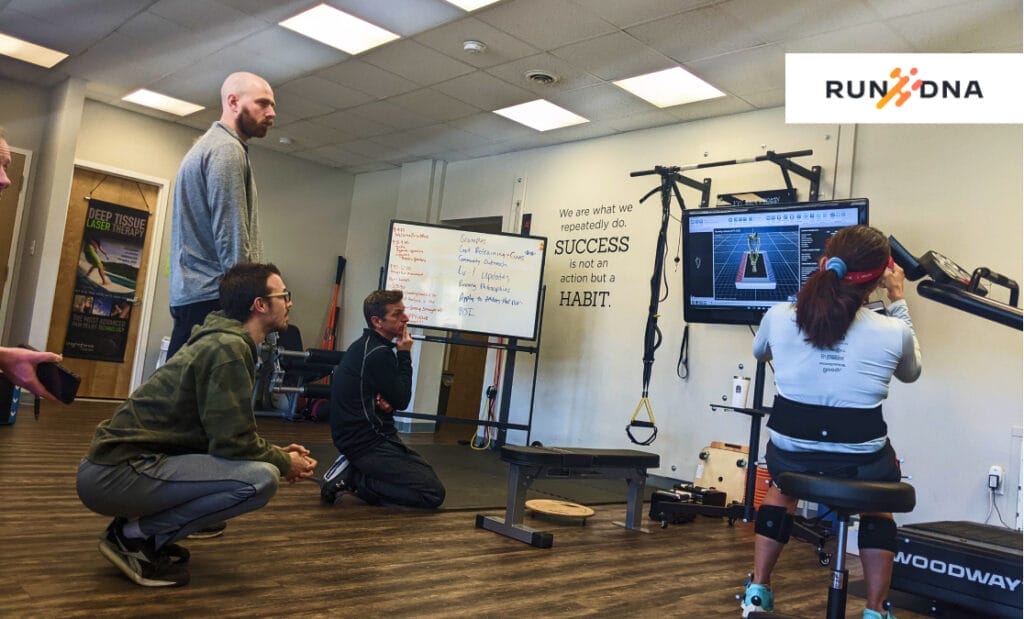For physical therapists, continuing education isn’t just a requirement—it’s a gateway to staying at the cutting edge of advancements and honing the skills that keep licensure up-to-date. The most impactful continuing education courses deepen your expertise and empower you to deliver the highest standard of care. This guide explores top-rated courses, highlights their unique benefits, and gives you the insights needed to choose a program that aligns with your goals, whether it’s enhancing general skills or pursuing a specialized certification like Physical Therapy Running.

What to Look For When Choosing the Best Physical Therapy Continuing Education Courses
Choosing the right courses is key to meeting your career goals and learning needs.
Here’s what you should look for in your search:
1 – Accreditation and Certification
Accreditation is the foundation of a good continuing education course. Programs accredited by recognized bodies like CAPTE or APTA meet high standards of quality and outcome. Choosing physical therapy certification courses from accredited providers means the education you get is recognized across the profession.
2 – Course Content and Curriculum
Good courses cover the topics that drive advanced practice. These are:
- Advanced manual therapy techniques
- Evidence-based management
- Sports injury management
- Neurological rehabilitation
- Geriatric and orthopedic physical therapy
Specialized courses in sports physical therapy or geriatric care allow you to specialize in different patient populations. Topics like running gait analysis certification can also increase your diagnostic skills if you work with athletes.
3 – Format
- Online Courses: Learn at your own pace and location.
- In-Person Courses: Hands-on with direct interaction.
- Hybrid Models: Online theory with in-person practical sessions.
Online physical therapy CEUs are good for therapists who need flexibility, while hybrid models allow for practical application with remote learning. Choose based on your needs and how much hands-on experience you need.
4 – Instructor Qualifications
Instructors with real-world experience bring valuable insights to the course. Look for:
- Professional background
- Relevant certifications and degrees
- Published work or field contributions
Check instructor profiles on reputable courses to make sure you’re learning from experts. For example, instructors with years of clinical experience in gait analysis add value to running gait analysis certification programs.
5 – Cost and Budget
Costs of continuing education courses can vary greatly, especially in-person courses that require travel or additional materials. Many programs offer financial assistance like scholarships, grants or employer sponsorship. Look into these options to make good education affordable.
The 5 Best Physical Therapy Continuing Education Courses for Professional Development

1 – Certified Running Gait Analyst by RunDNA
The Certified Running Gait Analyst program by RunDNA offers two progressive levels of certification, each designed to enhance the expertise of physical therapy professionals in running gait analysis and rehabilitation.
Level 1 Certified Running Gait Analyst
This foundational course is designed to teach the clinician how to assess and train runners correctly. Topics include:
- Runner Readiness Assessment: A screening tool to identify mobility and motor control limitations that affect a runner’s ability to move correctly and perform at their best.
- Five Categories of Running Gait Impairments: Detailed instruction on how to identify and treat the most common gait abnormalities that lead to injury.
- Corrective Programs: Online intervention programs to treat each impairment to use with your clients.
- Continuing Education Units (CEUs): Complete the course for 5 CEU hours to apply toward your license/certification.
Level 1 certification prepares clinicians to confidently analyze gait and treat running-related injuries with confidence.
Level 2 Certified Running Gait Analyst
For clinicians who treat a high volume of runners, Level 2 takes you deeper into advanced gait analysis and treatment techniques. Topics include:
- Twelve Categories of Running Gait Impairments: How to identify and treat even more gait abnormalities that lead to injury.
- Loading Levels Assessment: How to evaluate your runners with a plyometric test to determine their ability to handle dynamic loading.
- Injury-Specific Treatment Plans: How to create a comprehensive rehabilitation program for common running injuries, including strength and plyometric training.
- Continuing Education Units (CEUs): Complete the advanced course for 7 CEU hours to apply toward your license/certification.
Level 2 certification prepares the clinician to treat even the most challenging cases with advanced gait retraining, plyometric, and strength training.
Both levels of certification are designed to provide practical applications you can use immediately in your clinic. We’ve structured the course to follow our RunDNA™ process to ensure you can accurately assess, diagnose, and treat running-related gait impairments.

2 – Running Mechanics and Gait Analysis by Human Kinetics
Running Mechanics and Gait Analysis is a comprehensive course designed to enhance the clinical skills of physical therapy professionals in the evaluation and treatment of running-related injuries. The course dives deep into the mechanics of gait, injury assessment, and evidence-based intervention strategies.
Course Components
- Textbook: You will receive the print book “Running Mechanics and Gait Analysis.” This thorough resource references over 250 peer-reviewed scientific studies and covers both the clinical and research aspects of gait and injury analysis.
- Online Video Clips: The course includes access to 33 online video clips that demonstrate the common biomechanical patterns discussed in the textbook.
- Continuing Education Exam: An online exam tests knowledge and application of course information. Pass the exam and earn continuing education credits.
Continuing Education Units (CEUs)
This course is approved by the following professional organizations:
- ACE (American Council on Exercise): 0.40 CEUs
- ACSM (American College of Sports Medicine): 4.00 CEUs
- BOC (Board of Certification for Athletic Trainers): 2.25 CEUs
- NSCA (National Strength and Conditioning Association): 0.30 CEUs
These CEUs are important for meeting your state’s licensure and certification continuing education requirements.
Benefits for Physical Therapy Professionals
- Improved Assessment: A thorough joint-by-joint assessment is provided, helping clinicians identify common problems in runners and develop effective treatment protocols.
- Research-Based Interventions: The course references over 250 peer-reviewed scientific studies, allowing you to make interventions backed by current research.
- Clinical Utilization: Detailed clinical examples and case studies are provided to help you apply biomechanical analysis to your daily clinical practice.
3 – Course 1.0 Program by The Running Clinic
The Course 1.0 Program by The Running Clinic is a comprehensive training designed for healthcare professionals aiming to enhance their expertise in preventing and managing running-related injuries. Delivered over two days, this course integrates the latest scientific research with practical applications, challenging outdated practices and promoting evidence-based approaches.
Participants will gain proficiency in assessing injured runners, understanding the interplay between anatomy, biomechanics, and strength, and implementing interventions to reduce injury risk and boost performance. The curriculum covers running biomechanics, footwear selection, gait analysis, and retraining techniques, equipping professionals with the tools to provide effective, individualized care.
Upon completion, attendees are recognized as Certified Professionals by The Running Clinic, joining a global network of specialists committed to advancing the field of running injury prevention and treatment. This certification enhances professional credibility and connects practitioners with a community dedicated to continuous learning and excellence in runner care.
4 – Understanding Running Biomechanics by Evidence In Motion (EIM)
The Understanding Running Biomechanics course is not going to be a real barn burner, but it does offer a ton of great information for healthcare professionals that want to learn more about how to evaluate running gait patterns.
This on-demand webinar, presented by Jason Soncrant, is a great resource for clinicians to learn how to use their smartphones to evaluate running mechanics. The webinar covers how to set up a functional evaluation of a runner, how to use mobile video capture applications, and how to interpret the data. This is a great way to evaluate running mechanics without breaking the bank or setting up a fancy biomechanics lab.
Through video analysis of kinematic and kinetic variables, participants will learn how to evaluate contributing factors to poor running form and develop evidence-based interventions to improve performance and reduce injury risk. The webinar will also cover current research and trends in running biomechanics.
After completing this fun and informative webinar, clinicians will be able to perform a more detailed analysis of the running gait pattern and implement effective corrective exercises to improve running technique and help patients and clients achieve their running goals.
5 – Live Courses by Institute of Clinical Excellence
The Institute of Clinical Excellence (ICE) offers a comprehensive selection of live courses designed to advance the skills and knowledge of physical therapy professionals. These in-person programs emphasize evidence-based practices and hands-on learning, ensuring participants can effectively apply new techniques in their clinical settings.
Course Offerings
- Cervical Spine Management: This course focuses on the current best evidence-based principles for managing neck pain, enabling practitioners to refine their assessment and treatment strategies.
- Clinical Management of the Fitness Athlete: Live Seminar: Designed to equip therapists with the skills to assist fitness athletes in achieving optimal performance, this seminar covers injury prevention, performance enhancement, and rehabilitation techniques.
- ICE Pelvic Live: This course provides comprehensive training on treating and managing female athletes from preconception through postpartum, addressing pelvic floor dysfunctions, and promoting a safe return to sports.
- Dry Needling Courses: ICE offers both upper and lower body dry needling courses, focusing on safe and specific techniques combined with strategic electrical stimulation applications to address musculoskeletal conditions.
- Extremity Management: This course delves into the current best evidence for managing common extremity syndromes, enhancing practitioners’ ability to assess and treat upper and lower limb conditions.
- Lumbar Spine Management: Participants learn to apply evidence-based principles in managing low back pain, including manual therapy techniques and exercise prescription.
- Modern Management of the Older Adult: Live: This course emphasizes building strength and combating frailty in older adults, providing strategies to improve functional outcomes and quality of life.
- Professional Bike Fitting Certification: An evidence-based approach to evaluating and treating injured cyclists, this certification covers bike fitting principles and injury prevention strategies.
- Rehabilitation of the Injured Runner: Live: This course offers practical approaches to evaluating and treating running-related injuries, incorporating gait analysis and tailored rehabilitation programs.
- Total Spine Thrust Manipulation: Participants learn the evidence and skills necessary to perform thrust manipulations effectively for treating common spinal conditions.
CEU credits vary per course.
Elevate Your Expertise with the Best Continuing Education Courses
Continuing education is critical to professional growth and excellence in physical therapy.
By choosing the best continuing education courses in physical therapy, you can enhance your skills, stay updated with the latest advancements, and provide superior patient care.
Whether you opt for the comprehensive Certified Running Gait Analyst program by RunDNA or explore other top-tier options, investing in your education is a step toward a more prosperous and fulfilling career.
